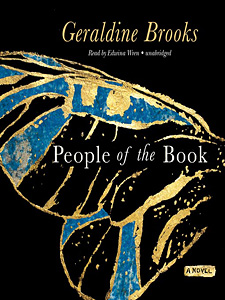 Geraldine Brooks is a very important author. Like Tim Winton, she is an unashamedly Australian writer who enjoys global recognition. People of the Book is her follow-up to the Pulitzer Prize-winning March, it has confirmed her status as an author with both gravitas and success, selling more than 100,000 copies in Australia alone, and recently taking out the Australian Book Industry Award for Book of the Year, 2008.
Geraldine Brooks is a very important author. Like Tim Winton, she is an unashamedly Australian writer who enjoys global recognition. People of the Book is her follow-up to the Pulitzer Prize-winning March, it has confirmed her status as an author with both gravitas and success, selling more than 100,000 copies in Australia alone, and recently taking out the Australian Book Industry Award for Book of the Year, 2008.
Like her previous novels, Brooks applies her journalistic skills in a narrative setting, writing an engaging tale that spans the centuries, in the process uniting the stories of Muslims, Christians and Jews around the theme of preserving a sacred text, the Sarajevo Haggadah.
The central character is an Australian, Hannah Heath, a renowned book conservator, called in to inspect and restore a medieval manuscript that has been recovered from the ruins of war-torn Sarajevo. It is a Jewish prayer book, and in her investigations she discovers a wine-stain, an insect leaf, some salt crystals and a hair that help her to begin to piece together the story of the book.
This book is part history, part romance and part detective novel, written with great skill and detail, and a breath-taking imagination.
Underlying the narrative is an unmistakable religious theme. Muslims risking their lives to save Jewish prayer books, a Christian involved in its creation and rescuing. The title itself is the term used by the Koran to refer to Christians and Jews, distinguishing them from infidels, and recognising the unifying feature of respect for the Old Testament.
In some ways this story is a personal quest by the author. Brooks describes her life as "one big oscillation between the attractions and repulsions of faith". She was raised a Catholic, but rejected the faith of her youth because of the way it isolated people into Us and Them. That theme figures prominently in the novel.
In one of life's little ironies, Brooks the atheist fell in love with a Jew and converted to his faith. Her conversion was not related to personal belief, but wanting to maintain the maternal line. She likes Jewish prayers, and quotes Salman Rushdie with his "God-shaped hole in society". She tries to fill that hole with her own prayers to something or someone. She says she likes writing about people who have a belief that has remained elusive for her.
Her background explains why she struggles to recognise the exclusivity of the different faiths, and the way that the Catholic Church is portrayed as a monolith, restrictive institution, marked by material privilege and hypocrisy.
There are some glimpses of beauty, though: generosity and grace and sacrifice and mercy and wonder and joy and perseverance and hope.
This is not a perfect book. Her research sometimes crowds the book and slows the pace; the dialogue is sometimes clumsy; and in some places the plot feels artificial. However, the strengths far outweigh these weaknesses.
This is an interesting and thought-provoking novel, especially suited to raising God-shaped questions in reading groups.
















